DOI:
10.1039/D1MA00881A
(Paper)
Mater. Adv., 2021,
2, 7662-7670
Development of highly sensitive fluorescent sensor and fluorescent sensor-doped polymer films for trace amounts of water based on photo-induced electron transfer†
Received
24th September 2021
, Accepted 14th October 2021
First published on 15th October 2021
Abstract
Anthracene-(aminomethyl)phenylboronic acid pinacol ester (AminoMePhenylBPin) SM-1 having a cyano group as an electron-withdrawing substituent and a hydroxymethyl group has been developed as a highly sensitive PET (photo-induced electron transfer)-type fluorescent sensor for visualization, detection, and quantification of trace amounts of water. SM-1 shows enhancement of fluorescence with the increase in water content in various solvents (polar, less polar, protic, and aprotic solvents), which is attributed to the suppression of PET due to the formation of the PET inactive (fluorescent) species SM-1a by interaction with water molecules. In fact, the formation of SM-1a by interaction with water molecules has been successfully detected by 1H NMR spectral measurements. The detection limits (DLs) and quantitation limits (QLs) of SM-1 for water in solvents are, respectively, 0.006 and 0.018 wt% in 1,4-dioxane, 0.004 and 0.012 wt% in THF, 0.004 and 0.013 wt% in acetonitrile, and 0.007 and 0.021 wt% in ethanol, which are superior to those of OF-2 without a hydroxymethyl group. This result is attributed to the improvement of fluorescence emission properties by the introduction of a hydroxymethyl group to an anthracene fluorophore. Actually, fluorescence quantum yields (Φfl) of OF-2 and SM-1 in absolute acetonitrile are below 2%, but in acetonitrile with 1 wt% water content the Φfl of SM-1 (20%) is higher than that of OF-2 (13%). Moreover, we have achieved the preparation of various types of polymer films (polystyrene (PS), poly(4-vinylphenol) (PVP), polyvinyl alcohol (PVA), and polyethylene glycol (PEG)) doped with SM-1, and investigated the optical sensing properties of the SM-1-doped polymer films for water. It was found that the SM-1-doped polymer films produce a reversible switching in fluorescence color between the green excimer emission in the PET active state under a drying process and the blue monomer emission in the PET inactive state upon exposure to moisture. Herein, we propose that PET-type fluorescent sensor-doped polymer films based on a fluorescence enhancement system are one of the most promising and convenient functional materials for not only environmental and quality control monitoring systems and industry, but also visualizing the droplet on material surfaces.
Introduction
Development of fluorescent sensors for the visualization as well as detection and quantification of trace amounts of water in solutions, solids, and gas or on material surfaces has been of considerable scientific and practical concerns in recent years, with the objective of not only the fundamental study in analytical chemistry, photochemistry, and photophysics, but also their potential applications to environmental and quality control monitoring systems and industry.1–14 Consequently, fluorescent sensors for water are one of the most promising functional materials contributing to the achievement of the 2030 agenda for Sustainable Development Goals (SDGs), which was adopted by all United Nations Member States in 2015 and provides a shared blueprint for the peace and prosperity of the people and the planet now and in the future. Actually, some kinds of organic fluorescent sensors and polymers for the determination of water content based on ICT (intramolecular charge transfer),15–24 ESIPT (excited state intramolecular proton transfer),25–28 PET (photo-induced electron transfer),29–36 or solvatochromism37–42 have been designed and synthesized. The optical sensing properties of these fluorescent sensors for the detection and quantification of water content were investigated from the viewpoints of the relationship between ICT, ESIPT, PET, or solvatochromic characteristics and the intermolecular interaction of the sensors with water molecules. As a result, it was found that most of the previously investigated fluorescent sensors for water, including fluorescent conjugated polymers43–46 and organic fluorescent dyes with ICT and ESIPT characteristics, are based on a fluorescence quenching (turn-off) system, that is, the fluorescence intensity of the sensors decreases as a function of water content in organic solvents. This fluorescence quenching system makes it difficult to detect trace amounts of water. In contrast, a fluorescence enhancement (turn-on) system exhibiting a fluorescence response with an increase in water content in organic solvents is useful for the visualization, detection, and quantification of trace amounts of water in organic solvents. In particular, the fluorescence enhancement system based on PET-type fluorescent sensors for water can detect a reversible change in its immediate environment due to the reversible intermolecular interactions between the sensors and water molecules. Thus, over the past few decades, we have designed and developed anthracene-(aminomethyl)phenylboronic acid pinacol esters (AminoMePhenylBPin) OM-1, OF-1, and OF-2 (Fig. 1a) as PET-type fluorescent sensors for the determination of trace amounts of water. OF-1 and OF-2 have a methoxy group as an electron-donating substituent and a cyano group as an electron-withdrawing substituent, respectively, at the para position on PhenylBPin.29–36 In each sensor, the PET takes place from the nitrogen atom of the amino moiety to the photoexcited fluorophore (anthracene) skeleton in the absence of water, leading to fluorescence quenching. The addition of water to organic solvents containing the PET-type fluorescent sensors causes a drastic and linear enhancement of fluorescence emission as a function of water content, which is attributed to the suppression of PET; that is, the nitrogen atom of the amino moiety is protonated or strongly interacts with water molecules, leading to the formation of the PET inactive (fluorescent) species such as OM-1a, OF-1a, or OF-2a.30,32 Moreover, it was found that the fluorescence sensing ability of the cyano-substituted sensor OF-2 for water is superior to those of the unsubstituted sensor OM-1 and the methoxy-substituted sensor OF-1. This result can be attributed to the fact that for OF-2, the cyano group at the para position on PhenylBPin enhances the Lewis acidity of the boron atom due to its electron-withdrawing effect, leading to the facilitation of the formation of the PET inactive (fluorescent) species by interaction with water molecules. In contrast, for OF-1, the electron-donating methoxy group at the para position on PhenylBPin diminishes the Lewis acidity of the boron atom, leading to the retardation of the formation of the PET inactive (fluorescent) species by the addition of water. Indeed, the detection limits (DLs) and quantitation limits (QLs) of OF-2 for water were, respectively, 0.01 wt% and 0.03 wt% in 1,4-dioxane, 0.008 wt% and 0.026 wt% in THF, 0.009 wt% and 0.026 wt% in acetonitrile, and 0.009 wt% and 0.027 wt% in ethanol, which are superior to those of OM-1 and OF-1, and are equivalent or superior to those of the fluorescence quenching systems (turn-off) based on the reported ICT-type15–24 and ESIPT-type25–28 fluorescent sensors. Thus, the PET method based on the fluorescence enhancement (turn-on) system makes it possible to visualize, detect, and determine trace amounts of water.
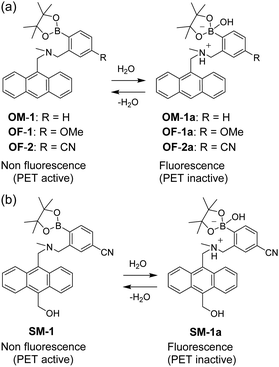 |
| | Fig. 1 Mechanisms of PET-type fluorescent sensors (a) OM-1, OF-1, OF-2, and (b) SM-1 for the detection of water in organic solvents. | |
Meanwhile, a novel coronavirus, severe acute respiratory syndrome coronavirus 2 (SARS-CoV-2) that causes Coronavirus Disease 2019 (COVID-19), dramatically changed the world to give people a sense of fear of death. Infectious viruses are generally released into the atmosphere through droplet spread from coughing and sneezing by an infected person. Thus, the infection route from an infected person to an uninfected person is predominately due to the droplet. Face shields made of polyester or polycarbonate films and partitions made of acrylic resin are commercially available for reducing the risk of droplet infection. Therefore, if we can visually confirm the droplet on face shields and partitions, this allows us to accurately remove the virus by wiping away the droplet. However, because the virus-containing droplet is generally only 5 μm or more, it is practically difficult for us to visually confirm the droplet. Meanwhile, over 90% of the droplet is composed of water, and thus, techniques and methods capable of visualizing water are undoubtedly useful for detecting the virus-containing droplet. For this purpose, in our previous work, in order to develop fluorescent polymeric materials for visualization and detection of water, we achieved the preparation of various types of polymer films (polystyrene (PS), poly(4-vinylphenol) (PVP), polyvinyl alcohol (PVA), and polyethylene glycol (PEG)) doped with the PET-type fluorescent sensor OF-2, and investigated the optical sensing properties of the OF-2-doped polymer films for water.47 It was found that the OF-2-doped polymer films exhibit a reversible switching in fluorescence color between the green excimer emission in the PET active state under a drying process and the blue monomer emission in the PET inactive state upon exposure to moisture or water droplets. To the best of our knowledge, our previous work was the first to achieve the preparation of PET-type fluorescent sensor-doped polymer films for water, although some fluorescent conjugated polymers43–46 and ICT-type22–24 or ESIPT-type27,28 fluorescent sensor-doped polymer films for water based on a fluorescence quenching (turn-off) system have been prepared. Nevertheless, in order to put the visualization of moisture and water droplets based on the PET method into practical applications, the development of a highly sensitive PET-type fluorescent sensor for trace amounts of water is required.
More recently, in our continuous work to gain insight into the optical sensing mechanism of PET-type fluorescent sensors for water, we found that the DLs and QLs of the PET-type fluorescent sensor OF-2 are dramatically improved by introducing a hydroxymethyl group on the anthracene skeleton, that is, development of the PET-type fluorescent sensor SM-1 (Fig. 1b). In this work, the formation of the PET inactive species OF-2a and SM-1a by interaction with water molecules has been successfully detected by 1H NMR spectral measurements. Furthermore, in order to develop fluorescent polymeric materials for the visualization and detection of water, we have achieved the preparation of various types of polymer films (PS, PVP, PVA, and PEG) doped with SM-1, and investigated the optical sensing properties of the SM-1-doped polymer films for water. Herein we propose that PET-type fluorescent sensor-doped polymer films based on a fluorescence enhancement system are one of the most promising and convenient functional materials for visualizing virus-containing droplets on the surfaces of face shields and partitions, and as such, will contribute to post-COVID19 society.
Results and discussion
A PET-type fluorescent sensor SM-1 was prepared by the reaction of (10-((methylamino)methyl)anthracen-9-yl)methanol48,49 with 3-(bromomethyl)-4-(4,4,5,5-tetramethyl-1,3,2-dioxaborolan-2-yl)benzonitrile (Scheme 1).
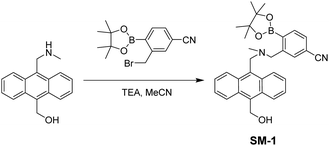 |
| | Scheme 1 Synthesis of SM-1. | |
In order to investigate the optical sensing ability of SM-1 for water in 1,4-dioxane and THF as less polar solvents, acetonitrile as a polar solvent, and ethanol as a protic solvent, the photoabsorption and fluorescence spectra of SM-1 were measured in the solvents containing various concentrations of water (Fig. 2). As with the case of OF-2,32 in all the four solvents, the photoabsorption spectra of SM-1 show a vibronically structured photoabsorption band in the range of 300 nm to 400 nm originating from the anthracene skeleton and did not undergo appreciable changes in the absorbance and shape upon the addition of water to the solution (Fig. 2a, c, e and g). In the corresponding fluorescence spectra, SM-1 in the absolute solvents exhibits a feeble and vibronically structured fluorescence band with a fluorescence maximum wavelength (λflmax) at around 420 nm in the range of 400 nm to 500 nm in the PET active state, which is attributed to the monomer emission originating from the anthracene skeleton (Fig. 2b, d, f and h). On the other hand, with the increase in the water content in the solutions, the fluorescence spectra exhibited an enhancement of the monomer emission band with a negligible change in their spectral shapes due to the suppression of PET (the PET inactive state). As shown in Fig. 3a, the acetonitrile solution of SM-1 did not show visual fluorescence emission, but exhibited blue fluorescence emission upon the addition of water.
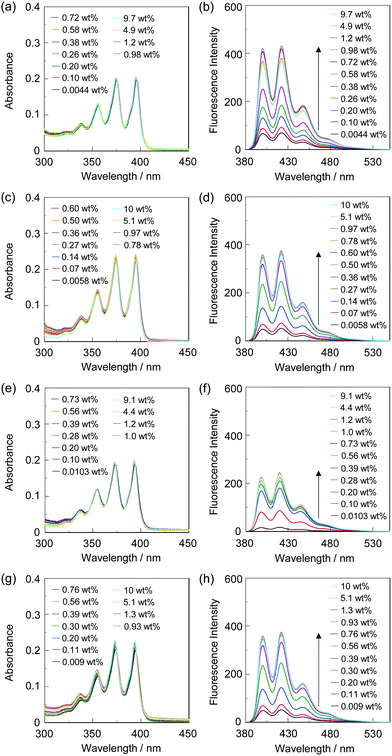 |
| | Fig. 2 (a) Photoabsorption and (b) fluorescence spectra (λex = 375 nm) of SM-1 (2.0 × 10−5 M) in 1,4-dioxane containing water (0.0044–9.7 wt%). (c) Photoabsorption and (d) fluorescence spectra (λex = 375 nm) of SM-1 (2.0 × 10−5 M) in THF containing water (0.0058–10 wt%). (e) Photoabsorption and (f) fluorescence spectra (λex = 373 nm) of SM-1 (2.0 × 10−5 M) in acetonitrile containing water (0.0103–9.1 wt%). (g) Photoabsorption and (h) fluorescence spectra (λex = 373 nm) of SM-1 (2.0 × 10−5 M) in ethanol containing water (0.009–10 wt%). | |
 |
| | Fig. 3 Photographs (under 254 nm irradiation) of (a) acetonitrile solution of SM-1 before and after addition of water and (b) 50 wt% SM-1-doped PVA film before and after exposure to moisture. | |
In order to estimate the sensitivity and accuracy of SM-1 for the detection of water in solvent, the changes in the fluorescence peak intensity at around 420 nm were plotted against the water fraction in the solvent (Fig. 4). As with the case of OF-2 (Fig. S2, ESI†),32 the plots of SM-1 demonstrated that the fluorescence peak intensity increased linearly as a function of the water content in all four solvents (Fig. 4a). Thus, the DLs and QLs of SM-1 for water in the solvents were determined based on the following equations: DL = 3.3σ/ms and QL = 10σ/ms, where σ is the standard deviation of the blank sample and ms is the slope of a calibration curve obtained from the plot of the fluorescence peak intensity at around 420 nm versus the water fraction in the low water content region below 1.0 wt% (Fig. 4b). The results are as follows:
| | | 1,4-Dioxane: F = 564.2[H2O] + 43.8 (R2 = 0.983, [H2O] = 0.0044–0.58 wt%) | (1) |
| | | THF: F = 819.6[H2O] + 31.5 (R2 = 0.989, [H2O] = 0.0058–0.36 wt%) | (2) |
| | | Acetonitrile: F = 753.5[H2O] + 13.1 (R2 = 0.975, [H2O] = 0.0103–0.28 wt%) | (3) |
| | | Ethanol: F = 484.2[H2O] + 12.6 (R2 = 0.979, [H2O] = 0.009–0.30 wt%) | (4) |
Indeed, the correlation coefficient (
R2) values for the calibration curves of
SM-1 are 0.975–0.989, which indicates good linearity, as with the case of
OF-2. However, a large difference in the
ms values between
SM-1 and
OF-2 was observed; that is, the
ms values for
SM-1 are, respectively, 564 in 1,4-dioxane, 819 in THF, 753 in acetonitrile, and 484 in ethanol and much larger than those of
OF-2 (
Table 1). The large
ms values for
SM-1 relative to
OF-2 can be attributed to the improvement in the fluorescence emission property by the introduction of a hydroxymethyl group to an anthracene fluorophore. Actually, fluorescence quantum yields (
Φfl) of
OF-2 and
SM-1 in absolute acetonitrile are below 2%, but in acetonitrile with 1 wt% water content the
Φfl (20%) of
SM-1 is higher than that (13%) of
OF-2. The DLs and QLs of
SM-1 for water are, respectively, 0.006 and 0.018 wt% in 1,4-dioxane, 0.004 and 0.012 wt% in THF, 0.004 and 0.013 wt% in acetonitrile, and 0.007 and 0.021 wt% in ethanol, which are superior to those of
OF-2. Consequently, it was found that the anthracene-AminoMePhenylBPin-based sensor
SM-1, with a cyano group as an electron-withdrawing substituent and a hydroxymethyl group, is a highly sensitive PET-type fluorescent sensor for the detection and quantification of trace amounts of water in polar, less polar, protic, and aprotic solvents.
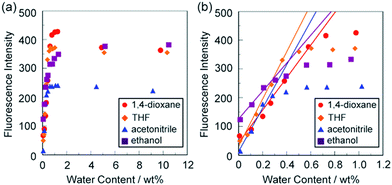 |
| | Fig. 4 Fluorescence peak intensity at around 420 nm of SM-1 (λex = 373–375 nm) as a function of water content below (a) 10 wt% and (b) 1.0 wt% in 1,4-dioxane, THF, acetonitrile, and ethanol. | |
Table 1 DL and QL of OF-2, SM-1, and previously reported ICT-type and ESIPT-type fluorescent sensors for water in various organic solvents
| Sensor |
Solvent |
m
s
|
DLb |
QLb |
|
Slope of calibration curve.
Detection limit (DL) and quantitation limit (QL) of the sensor for water.
|
|
OF-2
32
|
1,4-Dioxane |
334 |
0.01 wt% |
0.03 wt% |
| THF |
390 |
0.008 wt% |
0.026 wt% |
| Acetonitrile |
382 |
0.009 wt% |
0.026 wt% |
| Ethanol |
362 |
0.009 wt% |
0.027 wt% |
|
SM-1
|
1,4-Dioxane |
564 |
0.006 wt% |
0.018 wt% |
| THF |
819 |
0.004 wt% |
0.012 wt% |
| Acetonitrile |
753 |
0.004 wt% |
0.013 wt% |
| Ethanol |
484 |
0.007 wt% |
0.021 wt% |
| ICT-type15 |
1,4-Dioxane |
−40.23 |
0.008 wt% |
No data |
| Acetonitrile |
−52.10 |
0.006 wt% |
No data |
| Ethanol |
−22.42 |
0.015 wt% |
No data |
| ESIPT-type26 |
1,4-Dioxane |
−5.46 |
0.053 wt% |
No data |
| THF |
−10.38 |
0.006 wt% |
No data |
| Acetonitrile |
−7.63 |
0.011 wt% |
No data |
In order to confirm the mechanism of the PET-type fluorescent sensor based on the anthracene-AminoMePhenylBPin structure for the detection of water, we performed 1H NMR spectral measurements of OF-2 and SM-1 with and without the addition of water in the acetonitrile-d3 solution (2.0 × 10−2 M) (Fig. 5 and 6). Both the 1H NMR spectra of OF-2 and SM-1 solution (containing water content of 0.46 wt% and 0.18 wt%, respectively) without the addition of water show obvious signals which can be assigned to a single chemical species with OF-2 and SM-1 structures. On the other hand, for both the 1H NMR spectra of OF-2 and SM-1 solution with water content of 2.6 wt% and 2.8 wt%, respectively, some additional signals appear at both the aliphatic and aromatic regions, compared to that of the solution without the addition of water. Indeed, the 1H NMR spectra in the solutions with a water content of 2.6–2.8 wt% clearly indicate the existence of another chemical species as well as OF-2 and SM-1. Moreover, both the 1H NMR spectra of OF-2 and SM-1 solution with a water content of 11 wt% and 13 wt%, respectively can be assigned to a single chemical species which is quite different from the OF-2 and SM-1 structure, that is, the PET inactive species OF-2a and SM-1a (Fig. 1) occur upon the addition of water to the OF-2 and SM-1 solution, respectively. Consequently, upon the addition of water to OF-2 and SM-1 solution, the chemical shifts of the methyl protons Ha of boronic acid pinacol ester and the aromatic protons He and Hf of the anthracene skeleton show a considerable upfield shift, but the chemical shifts of Hj, Hk and Hl of the phenyl group and the methylene protons Hd on the anthracene skeleton show a considerable downfield shift. Furthermore, for the 1H NMR spectrum of the SM-1 solution with the addition of water, it is worth noting here that there is no appreciable change in chemical shifts for the methylene protons He of the hydroxymethyl group on an anthracene skeleton (Fig. 6). This fact indicates that for SM-1 the hydroxymethyl group does not act as a proton donor or acceptor which may affect the formation of the PET inactive species SM-1a through interaction with water molecules.
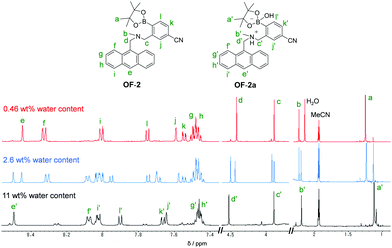 |
| | Fig. 5
1H NMR spectra of OF-2 (2.0 × 10−2 M) in acetonitrile-d3 with 0.46 wt%, 2.6 wt% and 11 wt% water content. | |
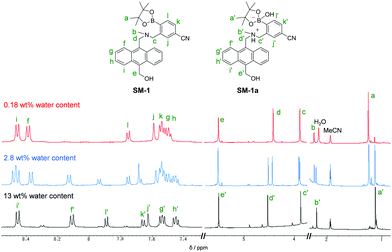 |
| | Fig. 6
1H NMR spectra of SM-1 (2.0 × 10−2 M) in acetonitrile-d3 with 0.18 wt%, 2.8 wt% and 13 wt% water content. | |
Next, in order to investigate the optical properties of SM-1 in the aggregate state, the spin-coated SM-1 film was prepared on a glass substrate, and the photoabsorption and fluorescence spectra of the spin-coated SM-1 film before and after exposure to moisture were repeatedly measured several times (Fig. 7). As with the case of OF-2 (Fig. S3, ESI†),47 the as-prepared spin-coated SM-1 film (in the dry process) shows a vibronically-structured photoabsorption band in the range of 300 nm to 400 nm originating from the anthracene skeleton (Fig. 7a). The photoabsorption spectral shape of the spin-coated SM-1 film did not undergo appreciable changes upon exposure to moisture, although a slight change in the absorbance during the repeated cycles was observed due to the disturbance of the baseline in the photoabsorption spectra. In the corresponding fluorescence spectra, the as-prepared spin-coated SM-1 film shows a broad fluorescence band in the range of 400 nm to 600 nm, which is assigned to the excimer emission originating from the anthracene skeleton in the PET active state (Fig. 7b). Interestingly, the spin-coated SM-1 film underwent a change in the fluorescence spectra upon exposure to moisture (in the wet process), which caused the vibronically-structured monomer emission (λflmax = ca. 420 nm) in the range of 400 nm to 500 nm arising from the PET inactive state. Moreover, it was found that when the spin-coated SM-1 film after exposure to moisture was dried in the atmosphere, the photoabsorption and fluorescence spectra showed the original spectral shapes before exposure to moisture, as with the case of OF-2. However, there is a difference in the ratio (Flmon/Flexm) of the intensity of the monomer to excimer emission between the spin-coated SM-1 and OF-2 film. The Flmon/Flexm of the spin-coated OF-2 film is higher than that of the spin-coated SM-1 film, that is, for the spin-coated OF-2 film, the Flmon is much larger than Flexm, but for the spin-coated SM-1 film, the Flmon is almost equal to Flexm. This result might be attributed to the idea that for SM-1 in the aggregate state, the excimer formation is facilitated by intermolecular hydrogen bonding between the hydroxymethyl groups. Thus, for the spin-coated SM-1 film, the reversibility of the fluorescence intensity between the excimer and monomer emissions in the dry-wet process was investigated (Fig. 7b inset). The dry-wet cycle shows that the monomer emission disappeared almost completely in the second wet process, as with the case of OF-2 (Fig. S3b inset, ESI†).47 The poor reversibility of the fluorescence intensity of the spin-coated SM-1 and OF-2 films between the excimer and monomer emissions may be attributed to destruction of the film during the dry-wet process.
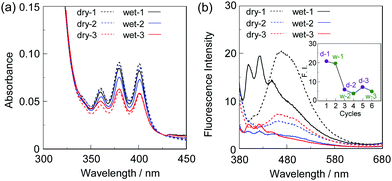 |
| | Fig. 7 (a) Photoabsorption and (b) fluorescence spectra (λex = 360 nm) of the spin-coated SM-1 film before (in dry process) and after (in wet process) exposure to moisture. For the photoabsorption spectra, baseline-correction has been made to be the same absorbance at 425 nm for all the spectra. The inset in (b) shows reversible switching of fluorescence intensity at around 480 nm in the dry process and at 420 nm in the wet process of the spin-coated SM-1 film. | |
In order to investigate the possibility for SM-1 to function in polymeric materials for the visualization and detection of water, we prepared various types of polymer films (PS, PVP, PVA, and PEG) doped with SM-1 at 50 wt%, and the photoabsorption and fluorescence spectra of the SM-1-doped polymer films before and after exposure to moisture were repeatedly measured several times (Fig. 8). As with the case of OF-2 (Fig. S4, ESI†),47 the as-prepared SM-1-doped polymer films (in the dry process) show a vibronically structured photoabsorption band in the range of 300 nm to 400 nm and a broad fluorescence band in the range of 400 nm to 600 nm attributable to the excimer emission originating from the anthracene skeleton in the PET active state (Fig. 8). When the OF-2-doped polymer films were exposed to moisture (in the wet process), the photoabsorption spectral shape did not undergo appreciable changes, although a slight change in the absorbance was observed due to the disturbance of the baseline in the photoabsorption spectra. The corresponding fluorescence spectra show a change in spectral shape from the broad excimer emission to the vibronically structured monomer emission (λflmax = 415 nm) arising from the PET inactive state upon exposure to moisture. In fact, one can see that an as-prepared SM-1-doped PVA film initially exhibits the green excimer emission in the PET active state, but the blue monomer emission in the PET inactive state upon exposure to moisture or water droplets (Fig. 3b). It is worth mentioning here that there are differences in the Flmon/Flexm of the intensity of the monomer to excimer emission between the four types of polymer films. For the SM-1-doped PS and PVP films, the Flexm is larger than Flmon, but for the SM-1-doped PVA and PEG films, the Flmon is larger than Flexm. In contrast, for all four OF-2-doped polymer films, the Flmon is larger than Flexm. This result suggests that for SM-1 in the polymer films, the excimer formation is facilitated in the hydrophobic PS and PVP films suitable for the formation of intermolecular hydrogen bonding between the hydroxymethyl groups, rather than in the hydrophilic PVA and PEG films. Indeed, for the fluorescence spectra of the SM-1-doped PS and PVP films, it is practically difficult to distinguish between the monomer and excimer emissions before and after exposure to moisture. The dry-wet cycles of the SM-1-doped polymer films show that for the SM-1-doped PVA and PEG films, a reversible switching in fluorescence intensity between the excimer and monomer emissions was obviously still observed in the third dry-wet process (Fig. 9). This result might be attributed to the idea that SM-1 has good compatibility with the hydrophilic PVA and PEG films rather than the hydrophobic PS and PVP films. In addition, the reversibility of the fluorescence intensity of the SM-1-doped PVA and PEG films is superior to that of the spin-coated SM-1 film (Fig. 7b inset). Therefore, it was found that for SM-1, the hydrophilic PVA and PEG films produce a good reversibility and a large change in the intensity between the excimer and monomer emissions during the dry-wet process, compared to the hydrophobic PS and PVP films, although all four OF-2-doped polymer films have a relatively good reversibility of the fluorescence intensity for moisture (Fig. S5, ESI†).47 Consequently, this work demonstrated that highly sensitive PET-type fluorescent sensor-doped polymer films exhibit a reversible switching between the excimer and monomer emissions during the dry-wet process, that is, enable the visualization and detection of moisture and water droplets.
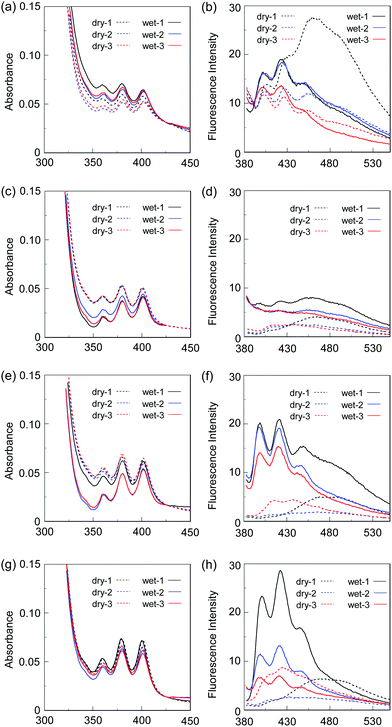 |
| | Fig. 8 (a) Photoabsorption and (b) fluorescence spectra (λex = 360 nm) of the spin-coated PS film with 50 wt% SM-1 before (in dry process) and after (in wet process) exposure to moisture. (c) Photoabsorption and (d) fluorescence spectra (λex = 360 nm) of the spin-coated PVP film with 50 wt% SM-1 before (in dry process) and after (in wet process) exposure to moisture. (e) Photoabsorption and (f) fluorescence spectra (λex = 360 nm) of the spin-coated PVA film with 50 wt% SM-1 before (in dry process) and after (in wet process) exposure to moisture. (g) Photoabsorption and (h) fluorescence spectra (λex = 360 nm) of the spin-coated PEG film with 50 wt% SM-1 before (in dry process) and after (in wet process) exposure to moisture. For all the photoabsorption spectra, baseline-correction has been made to be the same absorbance at 425 nm. | |
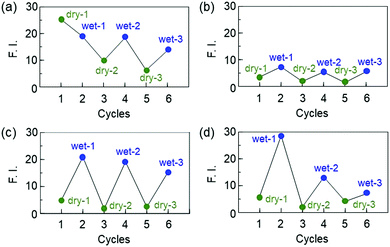 |
| | Fig. 9 Reversible switching of fluorescence intensity at around 480 nm in the dry process and at 420 nm in the wet process of 50 wt% SM-1-doped (a) PS, (b) PVP, (c) PVA, and (d) PEG films. | |
Conclusions
We have developed a highly sensitive PET-type fluorescent sensor based on the anthracene-AminoMePhenylBPin structure, SM-1 having a cyano group as an electron-withdrawing substituent and a hydroxymethyl group, for visualization, detection, and quantification of trace amounts of water. In fact, the formation of the PET inactive species SM-1a by interaction with water molecules has been successfully detected by 1H NMR spectral measurements. It was found that the introduction of a cyano group and a hydroxymethyl group to an anthracene-AminoMePhenylBPin structure can improve the sensitivity and accuracy of the PET-type fluorescent sensor for water. Moreover, we have achieved the preparation of various types of polymer films (PS, PVP, PVA, and PEG) doped with SM-1, and demonstrated that the SM-1-doped polymer films produce a reversible switching in fluorescence color between the green excimer emission in the PET active state under a drying process and the blue monomer emission in the PET inactive state upon exposure to moisture. Consequently, this work proposes that highly sensitive PET-type fluorescent sensor-doped polymer films are one of the most promising and convenient fluorescent polymeric materials for visualization and detection of moisture and water droplets.
Experimental
General
Melting points were measured using AS ONE ATM-02. IR spectra were recorded using a SHIMADZU IRTracer-100 spectrometer by the ATR method. 1H and 13C NMR spectra were recorded using a Varian-400 or Varian-500 FT NMR spectrometer. High-resolution mass spectral data obtained by APCI were acquired using Thermo Fisher Scientific LTQ Orbitrap XL. Photoabsorption spectra were observed using a SHIMADZU UV-3600 plus or UV-3150 spectrophotometer. Fluorescence spectra were measured using a Hitachi F-4500 spectrophotometer. The fluorescence quantum yields were determined using a Hamamatsu C9920-01 equipped with CCD using a calibrated integrating sphere system. The addition of water to 1,4-dioxane, THF, acetonitrile, or ethanol solutions containing SM-1 was made in terms of weight percent (wt%). The determination of water in solvents was performed using an MKC-610 and MKA-610 Karl Fischer moisture titrator (Kyoto Electronics Manufacturing Co., Ltd) based on Karl Fischer coulometric titration for below 1.0 wt% and volumetric titration for 1.0–10 wt%.
Synthesis
3-((((10-(Hydroxymethyl)anthracen-9-yl)methyl)(methyl)amino)methyl)-4-(4,4,5,5-tetramethyl-1,3,2-dioxaborolan-2-yl)benzonitrile (SM-1).
A solution of (10-((methylamino)methyl)anthracen-9-yl)methanol48,49 (0.25 g, 1.00 mmol), 3-(bromomethyl)-4-(4,4,5,5-tetramethyl-1,3,2-dioxaborolan-2-yl)benzonitrile (0.32 g, 1.00 mmol), triethylamine (0.55 mL, 3.96 mmol), and acetonitrile (33 mL) was stirred for 4 h at 80 °C under a nitrogen atmosphere. After concentrating under reduced pressure, the resulting residue was chromatographed on alumina (methanol![[thin space (1/6-em)]](https://www.rsc.org/images/entities/char_2009.gif) :
:![[thin space (1/6-em)]](https://www.rsc.org/images/entities/char_2009.gif) dichloromethane = 1
dichloromethane = 1![[thin space (1/6-em)]](https://www.rsc.org/images/entities/char_2009.gif) :
:![[thin space (1/6-em)]](https://www.rsc.org/images/entities/char_2009.gif) 40 as eluent) to give SM-1 (0.35 g, yield 71%) as a light yellow solid; m.p. 95–99 °C; FT-IR (ATR):
40 as eluent) to give SM-1 (0.35 g, yield 71%) as a light yellow solid; m.p. 95–99 °C; FT-IR (ATR): ![[small nu, Greek, tilde]](https://www.rsc.org/images/entities/i_char_e0e1.gif) = 2978, 2228, 1447, 1344, 1271, 1142 cm−1; 1H NMR (400 MHz, acetone-d6): δ = 1.29 (s, 12H), 2.29 (s, 3H), 4.01 (s, 2H), 4.48 (s, 2H), 5.60 (d, J = 5.4Hz, 2H), 7.49–7.56 (m, 4H), 7.64 (dd, J = 1.6 and 7.6 Hz, 1H), 7.74 (s, 1H), 7.88 (d, J = 7.6 Hz, 1H), 8.45 (dd, J = 3.3 and 7.7 Hz, 2H), 8.53 (dd, J = 3.5 and 7.9 Hz, 2H) ppm; 13C NMR (125 MHz, CDCl3): δ = 25.14, 42.95, 52.33, 57.52, 60.70, 83.95, 113.35, 119.21, 124.54, 125.50, 125.74, 125.93, 129.68, 129.94, 130.98, 131.34, 131.78, 131.87, 135.36, 146.18 ppm; HRMS (APCI): m/z (%): [M+˙] calcd for C31H33N2O3B, 492.25787; found 492.25879.
= 2978, 2228, 1447, 1344, 1271, 1142 cm−1; 1H NMR (400 MHz, acetone-d6): δ = 1.29 (s, 12H), 2.29 (s, 3H), 4.01 (s, 2H), 4.48 (s, 2H), 5.60 (d, J = 5.4Hz, 2H), 7.49–7.56 (m, 4H), 7.64 (dd, J = 1.6 and 7.6 Hz, 1H), 7.74 (s, 1H), 7.88 (d, J = 7.6 Hz, 1H), 8.45 (dd, J = 3.3 and 7.7 Hz, 2H), 8.53 (dd, J = 3.5 and 7.9 Hz, 2H) ppm; 13C NMR (125 MHz, CDCl3): δ = 25.14, 42.95, 52.33, 57.52, 60.70, 83.95, 113.35, 119.21, 124.54, 125.50, 125.74, 125.93, 129.68, 129.94, 130.98, 131.34, 131.78, 131.87, 135.36, 146.18 ppm; HRMS (APCI): m/z (%): [M+˙] calcd for C31H33N2O3B, 492.25787; found 492.25879.
Preparation of SM-1-doped polymer films
Polystyrene (PS), poly(4-vinylphenol) (PVP), or polyethylene glycol (PEG) (5 mg) was dissolved in a THF solution (1 mL) of SM-1 (5 mg) to form a 50 wt% stock solution. On the other hand, a THF solution (0.5 mL) of SM-1 (5 mg) was added to a polyvinyl alcohol (PVA) (5 mg) aqueous solution (0.5 mL) around 50 °C to form a 50 wt% stock solution. To prepare a polymer film, 300 μL of an SM-1-polymer solution was directly spin-coated (3000 rpm for 30 s) on a glass substrate (MIKASA MS-A-100 Opticoat Spincoater). The spin-coated films were dried in air. The resulting SM-1-doped polymer films were exposed to moisture for 60 s using a humidifier.
Conflicts of interest
There are no conflicts to declare.
Acknowledgements
This work was supported by Grants-in-Aid for Scientific Research (B) from the Japan Society for the Promotion of Science (JSPS) KAKENHI Grant Number 19H02754 and JST Adaptable and Seamless Technology transfer Program through Target-driven R&D (A-STEP) Grant Number JPMJTM20RB.
Notes and references
- H. S. Jung, P. Verwilst, W. Y. Kim and J. S. Kim, Fluorescent and colorimetric sensors for the detection of humidity or water content, Chem. Soc. Rev., 2016, 45, 1242–1256 RSC.
- P. Kumar, R. Sakla, A. Ghosh and D. A. Jose, Reversible Colorimetric Sensor for Moisture Detection in Organic Solvents and Application in Inkless Writing, ACS Appl. Mater. Interfaces, 2017, 9, 25600–25605 CrossRef CAS PubMed.
- Y. Zhou, G. Baryshnikov, X. Li, M. Zhu, H. Ågren and L. Zhu, Anti-Kasha's Rule Emissive Switching Induced by Intermolecular H-Bonding, Chem. Mater., 2018, 30, 8008–8016 CrossRef CAS.
- F. Wu, L. Wang, H. Tang and D. Cao, Excited State Intramolecular Proton Transfer Plus Aggregation-Induced Emission-Based Diketopyrrolopyrrole Luminogen: Photophysical Properties and Simultaneously Discriminative Detection of Trace Water in Three Organic Solvents, Anal. Chem., 2019, 91, 5261–5269 CrossRef CAS PubMed.
- S. Mishra and A. K. Singh, Optical sensors for water and humidity and their further applications, Coord. Chem. Rev., 2021, 445, 214063 CrossRef CAS.
- S. Song, Y. Zhang, Y. Yang, C. Wang, Y. Zhou, C. Zhang, Y. Zhao, M. Yang and Q. Lin, Ratiometric fluorescence detection of trace water in organic solvents based on aggregation-induced emission enhanced Cu nanoclusters, Analyst, 2018, 143, 3068–3074 RSC.
- H. Yan, S. Guo, F. Wu, P. Yu, H. Liu, Y. Li and L. Mao, Carbon Atom Hybridization Matters: Ultrafast Humidity Response of Graphdiyne Oxides, Angew. Chem., Int. Ed., 2018, 57, 3922–3926 CrossRef CAS PubMed.
- T. Maeda and F. Würthner, Halochromic and hydrochromic squaric acid functionalized perylene bisimide, Chem. Commun., 2015, 51, 7661–7664 RSC.
- W. Cheng, Y. Xie, Z. Yang, Y. Sun, M.-Z. Zhang, Y. Ding and W. Zhang, General Strategy for in Situ Generation of a Coumarin-Cu2+ Complex for Fluorescent Water Sensing, Anal. Chem., 2019, 91, 5817–5823 CrossRef CAS PubMed.
- J. Othong, J. Boonmak, F. Kielar and S. Youngme, Dual Function Based on Switchable Colorimetric Luminescence for Water and Temperature Sensing in Two-Dimensional Metal–Organic Framework Nanosheets, ACS Appl. Mater. Interfaces, 2020, 12, 41776–41784 CrossRef CAS PubMed.
- S. Roy, S. Das, A. Ray and P. P. Parui, An inquisitive fluorescence method for the real-time detection of trace moisture in polar aprotic solvents with the application of water rancidity in foodstuffs, New J. Chem., 2021, 45, 4574–4583 RSC.
- K. Nishino, H. Yamamoto, J. Ochi, K. Tanaka and Y. Chujo, Time-Dependent Emission Enhancement of the Ethynylpyrene-o-Carborane Dyad and Its Application as a Luminescent Color Sensor for Evaluating Water Contents in Organic Solvents, Chem. – Asian J., 2019, 14, 1577–1581 CrossRef CAS PubMed.
- K. Tanaka, K. Nishino, S. Ito, H. Yamane, K. Suenaga, K. Hashimoto and Y. Chujo, Development of solid-state emissive o-carboranes and theoretical investigation of the mechanism of the aggregation-induced emission behaviors of organoboron “element-blocks”, Faraday Discuss., 2017, 196, 31–42 RSC.
- H. Mori, K. Nishino, K. Wada, Y. Morisaki, K. Tanaka and Y. Chujo, Modulation of luminescence chromic behaviors and environment-responsive intensity changes by substituents in bis-o-carborane-substituted conjugated molecules, Mater. Chem. Front., 2018, 2, 573–579 RSC.
- C.-G. Niu, P.-Z. Qin, G.-M. Zeng, X.-Q. Gui and A.-L. Guan, Fluorescence sensor for water in organic solvents prepared from covalent immobilization of 4-morpholinyl-1, 8-naphthalimide, Anal. Bioanal. Chem., 2007, 387, 1067–1074 CrossRef CAS PubMed.
- Z. Li, Q. Yang, R. Chang, G. Ma, M. Chen and W. Zhang,
N-Heteroaryl-1,8-naphthalimide fluorescent
sensor for water: Molecular design, synthesis and properties, Dyes Pigm., 2011, 88, 307–314 CrossRef CAS.
- W. Chen, Z. Zhang, X. Li, H. Ågren and J. Su, Highly sensitive detection of low-level water content in organic solvents and cyanide in aqueous media using novel solvatochromic AIEE fluorophores, RSC Adv., 2015, 5, 12191–12201 RSC.
- S. Tsumura, T. Enoki and Y. Ooyama, A colorimetric and fluorescent sensor for water in acetonitrile based on intramolecular charge transfer: D–(π–A)2-type pyridine–boron trifluoride complex, Chem. Commun., 2018, 54, 10144–10147 RSC.
- T. Enoki and Y. Ooyama, Colorimetric and ratiometric fluorescence sensing of water based on 9-methyl pyrido[3,4-b]indole-boron trifluoride complex, Dalton Trans., 2019, 48, 2086–2092 RSC.
- K. Imato, T. Enoki and Y. Ooyama, Development of an intramolecular charge transfer-type colorimetric and fluorescence sensor for water by fusion with a juloidine structure and complexation with boron trifluoride, RSC Adv., 2019, 9, 31466–31473 RSC.
- S. Tusmura, K. Ohira, K. Imato and Y. Ooyama, Development of optical sensor for water in acetonitrile based on propeller-structured BODIPY-type pyridine–boron trifluoride complex, RSC Adv., 2020, 10, 33836–33843 RSC.
- D. Citterio, K. Minamihashi, Y. Kuniyoshi, H. Hisamoto, S. Sasaki and K. Suzuki, Optical determination of low-level water concentrations in organic solvents using fluorescent acridinyl dyes and dye-immobilized polymer membranes, Anal. Chem., 2001, 73, 5339–5345 CrossRef CAS PubMed.
- C.-G. Niu, A.-L. Guan, G.-M. Zeng, Y.-G. Liu and Z.-W. Li, Fluorescence water sensor based on covalent immobilization of chalcone derivative, Anal. Chim. Acta, 2006, 577, 264–270 CrossRef CAS PubMed.
- Z.-Z. Li, C.-G. Niu, G.-M. Zeng and P.-Z. Qin, Fluorescence Sensor for Water Content in Organic Solvents Based on Covalent Immobilization of Benzothioxanthene, Chem. Lett., 2009, 38, 698–699 CrossRef CAS.
- W. Liu, Y. Wang, W. Jin, G. Shen and R. Yu, Solvatochromogenic flavone dyes for the detection of water in acetone, Anal. Chim. Acta, 1999, 383, 299–307 CrossRef CAS.
- J. S. Kim, M. G. Choi, Y. Huh, M. H. Kim, S. H. Kim, S. Y. Wang and S.-K. Chang, Determination of Water Content in Aprotic Organic Solvents Using 8-Hydroxyquinoline Based Fluorescent Probe, Bull. Korean Chem. Soc, 2006, 27, 2058–2060 CrossRef CAS.
- H. Mishra, V. Misra, M. S. Mehata, T. C. Pant and H. B. Tripathi, Fluorescence Studies of Salicylic Acid Doped Poly(vinyl alcohol) Film as a Water/Humidity Sensor, J. Phys. Chem. A, 2004, 108, 2346–2352 CrossRef CAS.
- A. C. Kumar and A. K. Mishra, 1-Naphthol as an excited state proton transfer fluorescent probe for sensing bound-water hydration of polyvinyl alcohol, Talanta, 2007, 71, 2003–2006 CrossRef CAS PubMed.
- Y. Ooyama, M. Sumomogi, T. Nagano, K. Kushimoto, K. Komaguchi, I. Imae and Y. Harima, Detection of water in organic solvents by photo-induced electron transfer method, Org. Biomol. Chem., 2011, 9, 1314–1316 RSC.
- Y. Ooyama, A. Matsugasako, K. Oka, T. Nagano, M. Sumomogi, K. Komaguchi, I. Imae and Y. Harima, Fluorescence PET (photo-induced electron transfer) sensors for water based on anthracene–boronic acid ester, Chem. Commun., 2011, 47, 4448–4450 RSC.
- Y. Ooyama, A. Matsugasako, Y. Hagiwara, J. Ohshita and Y. Harima, Highly sensitive fluorescence PET (photo-induced electron transfer) sensor for water based on anthracene–bisboronic acid ester, RSC Adv., 2012, 2, 7666–7668 RSC.
- Y. Ooyama, K. Furue, K. Uenaka and J. Ohshita, Development of highly-sensitive fluorescence PET (photo-induced electron transfer) sensor for water: anthracene–boronic acid ester, RSC Adv., 2014, 4, 25330–25333 RSC.
- Y. Ooyama, M. Hato, T. Enoki, S. Aoyama, K. Furue, N. Tsunoji and J. Ohshita, A BODIPY sensor for water based on a photo-induced electron transfer method with fluorescence enhancement and attenuation systems, New J. Chem., 2016, 40, 7278–7281 RSC.
- Y. Ooyama, R. Sagisaka, T. Enoki, N. Tsunoji and J. Ohshita, Tetraphenylethene– and diphenyldibenzofulvene–anthracene-based fluorescence sensors possessing photo-induced electron transfer and aggregation-induced emission enhancement characteristics for detection of water, New J. Chem., 2018, 42, 13339–13350 RSC.
- D. Jinbo, K. Imato and Y. Ooyama, Fluorescent sensor for water based on photo-induced electron transfer and Förster resonance energy transfer: anthracene-(aminomethyl)phenylboronic acid ester-BODIPY structure, RSC Adv., 2019, 9, 15335–15340 RSC.
- D. Jinbo, K. Ohira, K. Imato and Y. Ooyama, Development of fluorescent sensors based on a combination of PET (photo-induced electron transfer) and FRET (Förster resonance energy transfer) for detection of water, Mater. Adv., 2020, 1, 354–362 RSC.
- L. Ding, Z. Zhang, X. Li and J. Su, Highly sensitive determination of low-level water content in organic solvents using novel solvatochromic dyes based on thioxanthone, Chem. Commun., 2013, 49, 7319–7321 RSC.
- Y. Zhang, D. Li, Y. Li and J. Yu, Solvatochromic AIE luminogens as supersensitive water detectors in organic solvents and highly efficient cyanide chemosensors in water, Chem. Sci, 2014, 5, 2710–2716 RSC.
- Y. Mise, K. Imato, T. Ogi, N. Tsunoji and Y. Ooyama, Fluorescence sensors for detection of water based on tetraphenylethene–anthracene possessing both solvatofluorochromic properties and aggregation-induced emission (AIE) characteristics, New J. Chem., 2021, 45, 4164–4173 RSC.
- N. Zhao, Z. Yang, J. W. Y. Lam, H. H. Y. Sung, N. Xie, S. Chen, H. Su, M. Gao, I. D. Williams, K. S. Wong and B. Z. Tang, Benzothiazolium-functionalized tetraphenylethene: an AIE luminogen with tunable solid-state emission, Chem. Commun., 2012, 48, 8637–8639 RSC.
- X. Y. Shen, Y. J. Wang, H. Zhang, A. Qin, J. Z. Sun and B. Z. Tang, Conjugates of tetraphenylethene and diketopyrrolopyrrole: tuning the emission properties with phenyl bridges, Chem. Commun., 2014, 50, 8747–8750 RSC.
- F. Khan, A. Ekbote, S. M. Mobin and R. Misra, Mechanochromism and Aggregation-Induced Emission in Phenanthroimidazole Derivatives: Role of Positional Change of Different Donors in a Multichromophoric Assembly, J. Org. Chem., 2021, 86, 1560–1574 CrossRef CAS PubMed.
- Q. Deng, Y. Li, J. Wu, Y. Liu, G. Fang, S. Wang and Y. Zhang, Highly sensitive fluorescent sensing for water based on poly(m-aminobenzoic acid), Chem. Commun., 2012, 48, 3009–3011 RSC.
- W.-E. Lee, Y.-J. Jin, L.-S. Park and G. Kwak, Fluorescent Actuator Based on Microporous Conjugated Polymer with Intramolecular Stack Structure, Adv. Mater., 2012, 24, 5604–5609 CrossRef CAS PubMed.
- D.-C. Han, Y.-J. Jin, J.-H. Lee, S.-I. Kim, H.-J. Kim, K.-H. Song and G. Kwak, Environment-Specific Fluorescence Response of Microporous, Conformation-Variable Conjugated Polymer Film to Water in Organic Solvents: On-line Real-Time Monitoring in Fluidic Channels, Macromol. Chem. Phys., 2014, 215, 1068–1076 CrossRef CAS.
- J. Lee, M. Pyo, S. Lee, J. Kim, M. Ra, W.-Y. Kim, B. J. Park, C. W. Lee and J.-M. Kim, Hydrochromic conjugated polymers for human sweat pore mapping, Nat. Commun., 2014, 5, 3736 CrossRef CAS PubMed.
- T. Fumoto, S. Miho, Y. Mise, K. Imato and Y. Ooyama, Polymer films doped with fluorescent sensor for moisture and water droplet based on photo-induced electron transfer, RSC Adv., 2021, 11, 17046–17050 RSC.
- W. Yang, H. Fan, X. Gao, S. Gao, V. Vardhan, R. Karnati, W. Ni, W. B. Hooks, J. Carson, B. Weston and B. Wang, The First Fluorescent Diboronic Acid Sensor Specific for Hepatocellular Carcinoma Cells Expressing Sialyl Lewis X, Chem. Biol., 2004, 11, 439–448 CrossRef CAS PubMed.
- Y.-I. Lin, S. A. Lang Jr., C. M. Seifert, R. G. Child, G. O. Morton and P. F. Fabio, Aldehyde Syntheses. Study of the preparation of 9,10-anthracenedicarboxaldehyde, J. Org. Chem., 1979, 44, 4701–4703 CrossRef CAS.
Footnote |
| † Electronic supplementary information (ESI) available. See DOI: 10.1039/d1ma00881a |
|
| This journal is © The Royal Society of Chemistry 2021 |
Click here to see how this site uses Cookies. View our privacy policy here.  Open Access Article
Open Access Article a,
Seiji
Akiyama
b,
Mio
Ishida
b and
Yousuke
Ooyama
a,
Seiji
Akiyama
b,
Mio
Ishida
b and
Yousuke
Ooyama
 *a
*a






![[thin space (1/6-em)]](https://www.rsc.org/images/entities/char_2009.gif) :
:![[thin space (1/6-em)]](https://www.rsc.org/images/entities/char_2009.gif) dichloromethane = 1
dichloromethane = 1![[thin space (1/6-em)]](https://www.rsc.org/images/entities/char_2009.gif) :
:![[thin space (1/6-em)]](https://www.rsc.org/images/entities/char_2009.gif) 40 as eluent) to give SM-1 (0.35 g, yield 71%) as a light yellow solid; m.p. 95–99 °C; FT-IR (ATR):
40 as eluent) to give SM-1 (0.35 g, yield 71%) as a light yellow solid; m.p. 95–99 °C; FT-IR (ATR): ![[small nu, Greek, tilde]](https://www.rsc.org/images/entities/i_char_e0e1.gif) = 2978, 2228, 1447, 1344, 1271, 1142 cm−1; 1H NMR (400 MHz, acetone-d6): δ = 1.29 (s, 12H), 2.29 (s, 3H), 4.01 (s, 2H), 4.48 (s, 2H), 5.60 (d, J = 5.4Hz, 2H), 7.49–7.56 (m, 4H), 7.64 (dd, J = 1.6 and 7.6 Hz, 1H), 7.74 (s, 1H), 7.88 (d, J = 7.6 Hz, 1H), 8.45 (dd, J = 3.3 and 7.7 Hz, 2H), 8.53 (dd, J = 3.5 and 7.9 Hz, 2H) ppm; 13C NMR (125 MHz, CDCl3): δ = 25.14, 42.95, 52.33, 57.52, 60.70, 83.95, 113.35, 119.21, 124.54, 125.50, 125.74, 125.93, 129.68, 129.94, 130.98, 131.34, 131.78, 131.87, 135.36, 146.18 ppm; HRMS (APCI): m/z (%): [M+˙] calcd for C31H33N2O3B, 492.25787; found 492.25879.
= 2978, 2228, 1447, 1344, 1271, 1142 cm−1; 1H NMR (400 MHz, acetone-d6): δ = 1.29 (s, 12H), 2.29 (s, 3H), 4.01 (s, 2H), 4.48 (s, 2H), 5.60 (d, J = 5.4Hz, 2H), 7.49–7.56 (m, 4H), 7.64 (dd, J = 1.6 and 7.6 Hz, 1H), 7.74 (s, 1H), 7.88 (d, J = 7.6 Hz, 1H), 8.45 (dd, J = 3.3 and 7.7 Hz, 2H), 8.53 (dd, J = 3.5 and 7.9 Hz, 2H) ppm; 13C NMR (125 MHz, CDCl3): δ = 25.14, 42.95, 52.33, 57.52, 60.70, 83.95, 113.35, 119.21, 124.54, 125.50, 125.74, 125.93, 129.68, 129.94, 130.98, 131.34, 131.78, 131.87, 135.36, 146.18 ppm; HRMS (APCI): m/z (%): [M+˙] calcd for C31H33N2O3B, 492.25787; found 492.25879.




